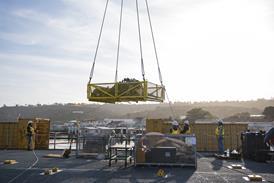Dave Higdon/WICHITA
VisionAire's single engined Vantage will be heavier, longer and costlier, following an extensive six-month design review. The move compounds the Ames, Iowa-based firm's charge that the Vantage is a new jet for the 21st century, as certification and first deliveries have been pushed back by about 18 months, from late this year to 2001.
The alterations, expected to be formally announced at the end of this month, include a second weight gain in a year to accommodate several airframe changes, a further extension of the jet's development schedule to early 2001 and a 20% price hike from $1.8 million to $2.2 million.
The Vantage will be certificated to a new maximum gross take-off weight of 3,720kg (8,200lb), an increase of 180kg. The empty weight will be increased by 195kg, to 2,000kg, while the full-cabin payload remains at 560kg. The fuselage will be stretched by up to 150mm and the twin engine inlets will be moved higher on the fuselage to eliminate turbulence at high angles that contributed to a low-speed handling problem.
VisionAire will also move the forward and aft pressure bulkheads to give the cockpit and cabin more room, while the wing's forward sweep will be reduced to improve low-speed handling. Fowler flaps will replace the existing system.
The wing and flap alterations are designed to keep the stall speed below 70kt (130km/h) to enable the aircraft to be certificated under US Federal Aviation Regulation Part 23 and eliminate the necessity for a stick shaker system which would "add weight and complexity".
To handle the increased weight, VisionAire will use the higher-thrust Pratt & Whitney JT15D-5D instead of the original JT15D-5 powerplant. The higher operating weights will cut about 10% off the full-cabin range of 1,850km (1,000nm).
With a full 1,300kg of fuel, the Vantage can still fly 2,500km at 250kt, a 90km reduction on earlier specifications.
Visionaire's exhaustive search for investors appears near its end, following a $75 million cash injection from private investors, which will provide funding for a new prototype and settle outstanding debts. Steve Goodhue, vice-president of corporate relations says: "Our investment activities are picking up speed and we are now on target to have the full $100 million [to fund the entire certification programme] by the end of the year."
Source: Flight International























